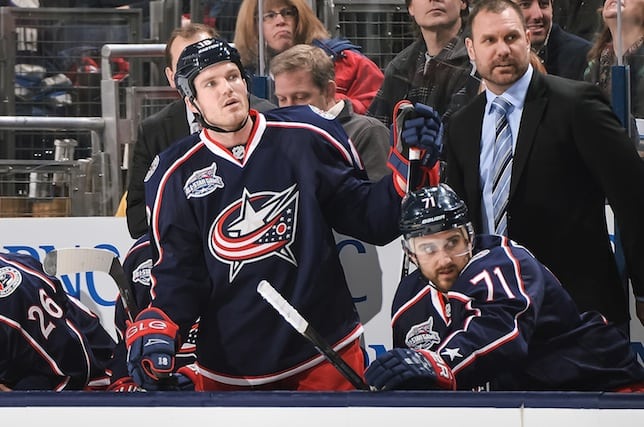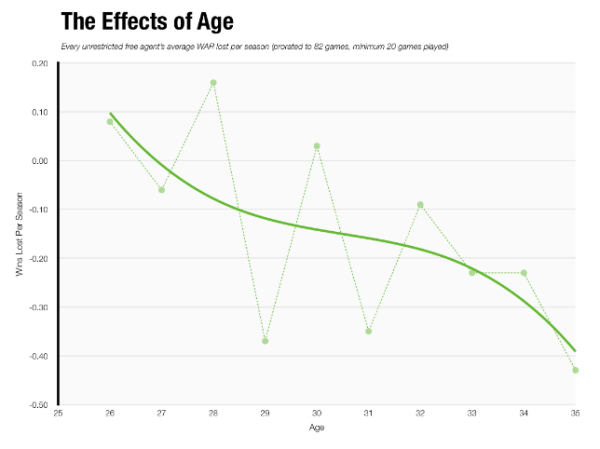
In two days, the NHL free agency period officially begins and it could be another day of vast overpayment for massive underproduction. It’s often a day many GMs come to regret, as underlying numbers show contracts handed out on the opening day of free agency can come back to create salary cap woes in no time.
 Numbers show free agent frenzy lends itself to bad contracts
Numbers show free agent frenzy lends itself to bad contractsThe NHL’s annual free agent frenzy begins Wednesday which means teams are loading up the metaphorical Brinks truck in preparation of overpaying a player you will likely grow to dislike in three years – maybe less. Seriously, go through the past few frenzies and find all the players you’d welcome on your favorite team right now at their current cap hit. The list is likely very short, and considering this year’s offerings, that probably won’t change. It’s pretty simple as to why that is: age. Player’s can become unrestricted free agents at 27 – although there are a lot of exceptions and complications to that rule – which is generally the beginning of a player’s decline. That doesn’t apply to all players, especially the really good ones, but it’s not wise to bank on exceptions to the rule.
Yet that’s exactly what GMs are doing by paying top dollar for a player that’s already becoming a shadow of what he once was.
War-On-Ice’s newly minted wins above replacement stat, or WAR for short, can illuminate that.
What WAR essentially does is put a value to every on-ice contribution that a player makes – from faceoffs to scoring to shot rates – and then compares it against what the average replacement-level (think non-regulars or guys who spend a lot of time in the press box) player does. On-ice value is essentially what GMs are after when scouring the market so putting one number to a player’s game is a good way of measuring if they’re getting value, even if it’s not an absolutely perfect measurement. We know players decline at or around 27, but the real question is are GMs accounting for it? Looking only at players who signed with three of more years of term – the guys the GMs really believe in – it sure doesn’t seem like it.
Players are essentially getting paid for what they have done, not what they’re going to do. Almost every green dot (contract year) is well above replacement level while an alarming amount of red dots (two seasons after a contract year) are below. I’m going to bet that’s not what the GMs paid for and that’s the risk that comes with paying for a player’s past production instead of their future worth. Obviously, that’s harder to predict, but assuming the player is going to continue producing as he did in his prime past the age of 27 is usually going to lead to disappointment. While a lot of the drop-off can be attributed to age, there’s another factor at play here. Separating the free agents into three tiers based on the percentage of salary cap space being taken shows that the above trend actually only effects one group: the middle class.
On average, the free agents being paid between 5-10 percent of a team’s cap space dropped one win in just two seasons. Again, I’m betting that’s not what the GMs paid for. The elite guys who signed big deals, unsurprisingly, stayed consistent, while the bargain bin players stayed fairly close too. So, what gives? It’s about the types of players you’ll find in each tier that’s contributing to this. The elite guys will contribute to any team and don’t drop off as quickly. They’re worth the big bucks. The bargains are usually role players or under-the-radar guys, usually good value where what you see is what you get, maybe more. And the middle class are usually middle-of-the-lineup players, where it all depends on fit. In the right situation, they’re a great addition, especially as a “missing piece” to a contender that already has top players to do the heavy lifting. But, far too often, the middle class are the top options available and teams with holes try to shove these players into places where they don’t belong. That right there is the biggest indictment of the entire free agent frenzy. There are rarely any elite players available so teams are forced to overpay a declining, middling player and force him way too high up the lineup. What it all boils down to is that it’s hard to trust what you’re going to get with a free agent and that’s why it’s best not to go all in on a complimentary player, especially as they get older. Those aren’t the players to invest a huge chunk of precious cap space in. If there’s a
Zach Parise or
Marian Hossa out there, by all means break the bank. But when the top of the class is a
David Clarkson or
Matt Beleskey, what you’re getting isn’t worth the price of admission. And it’ll only get worse, too.




